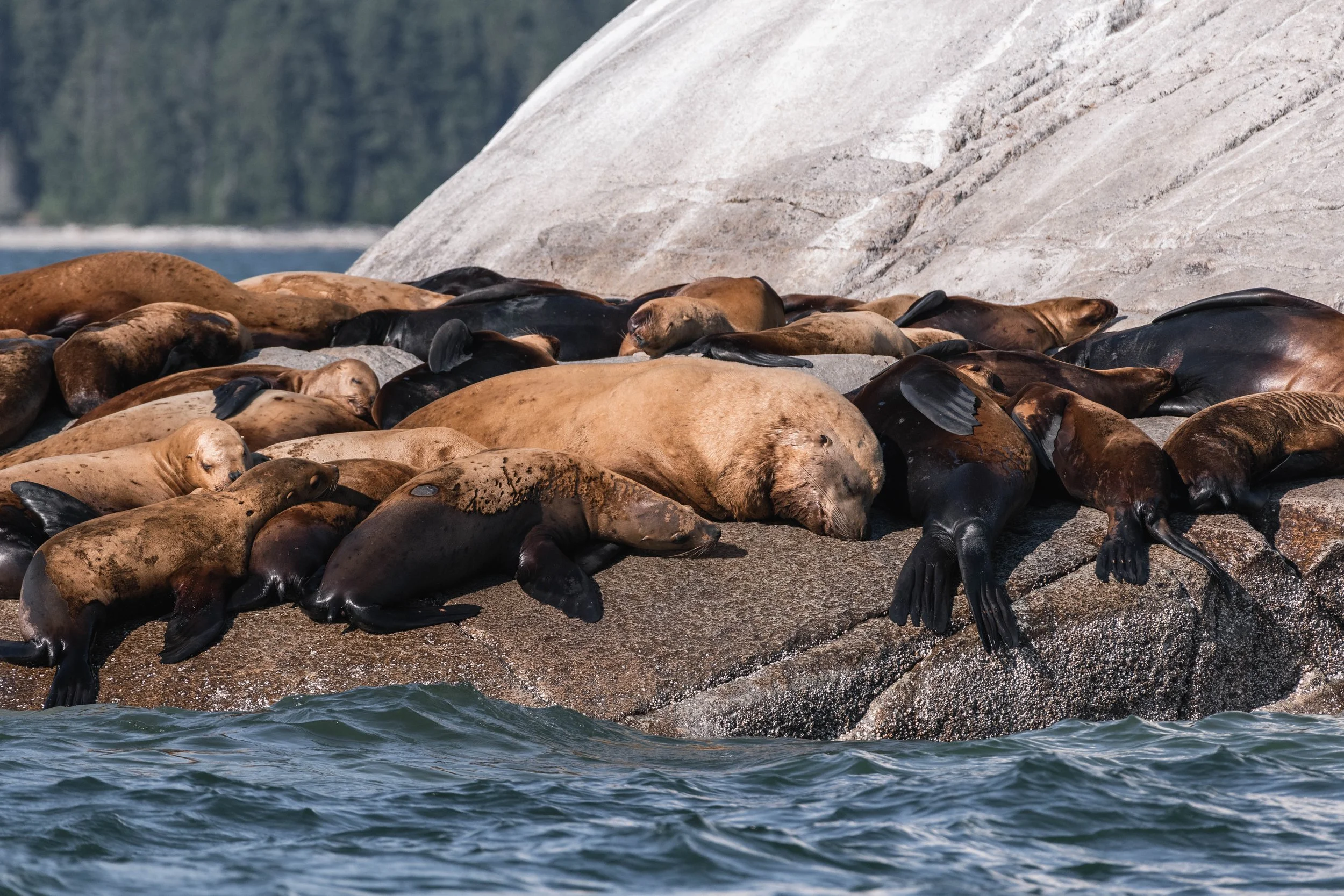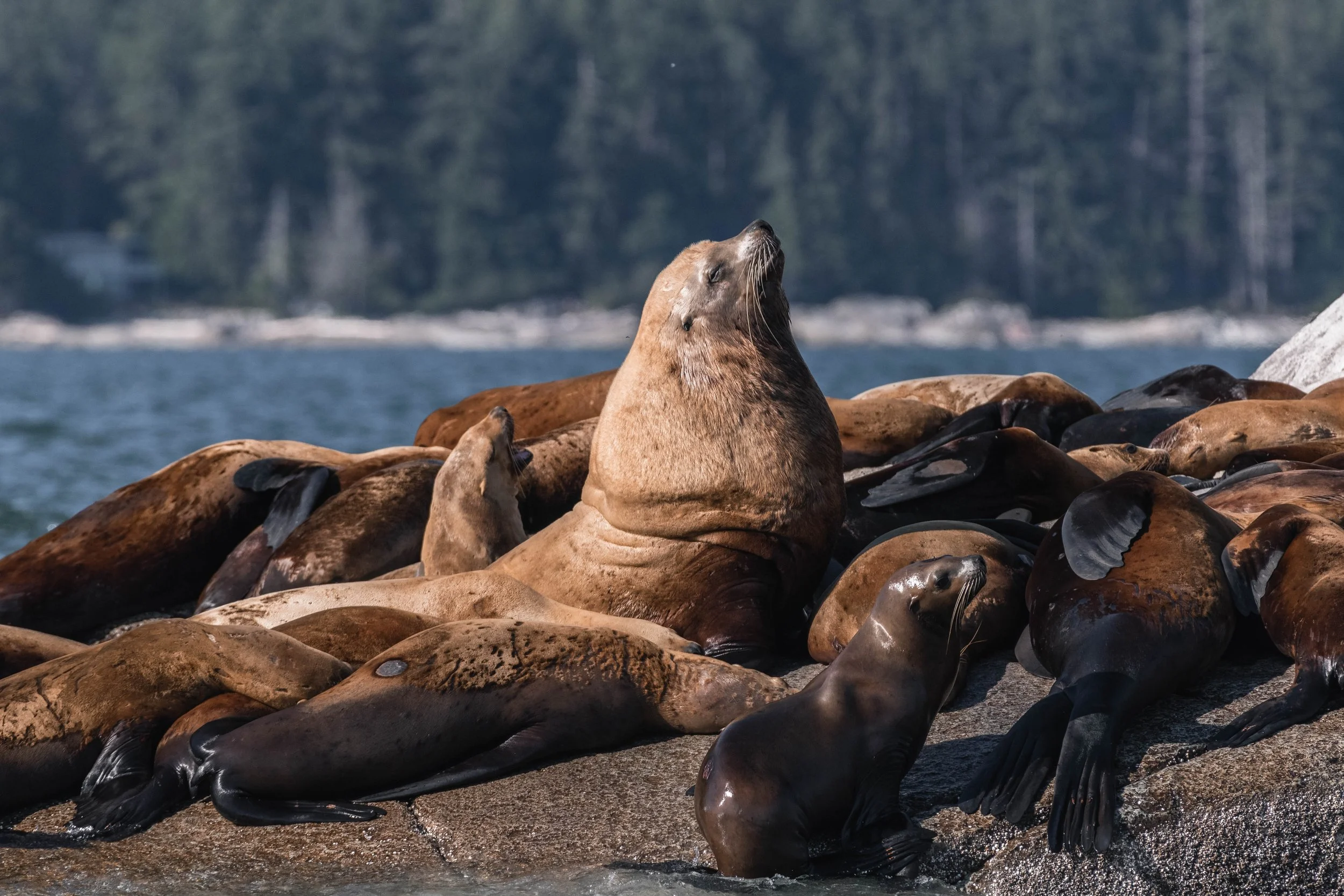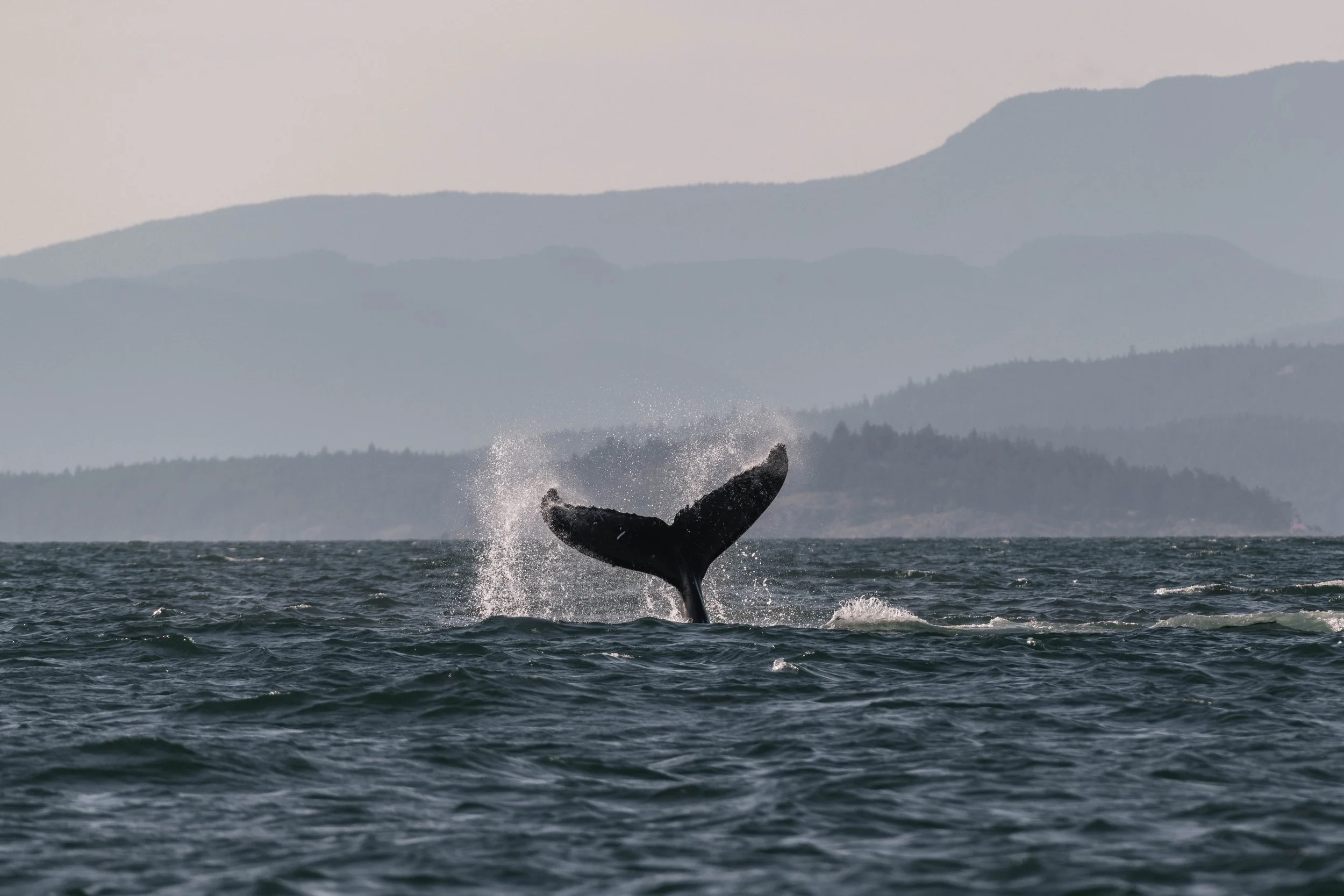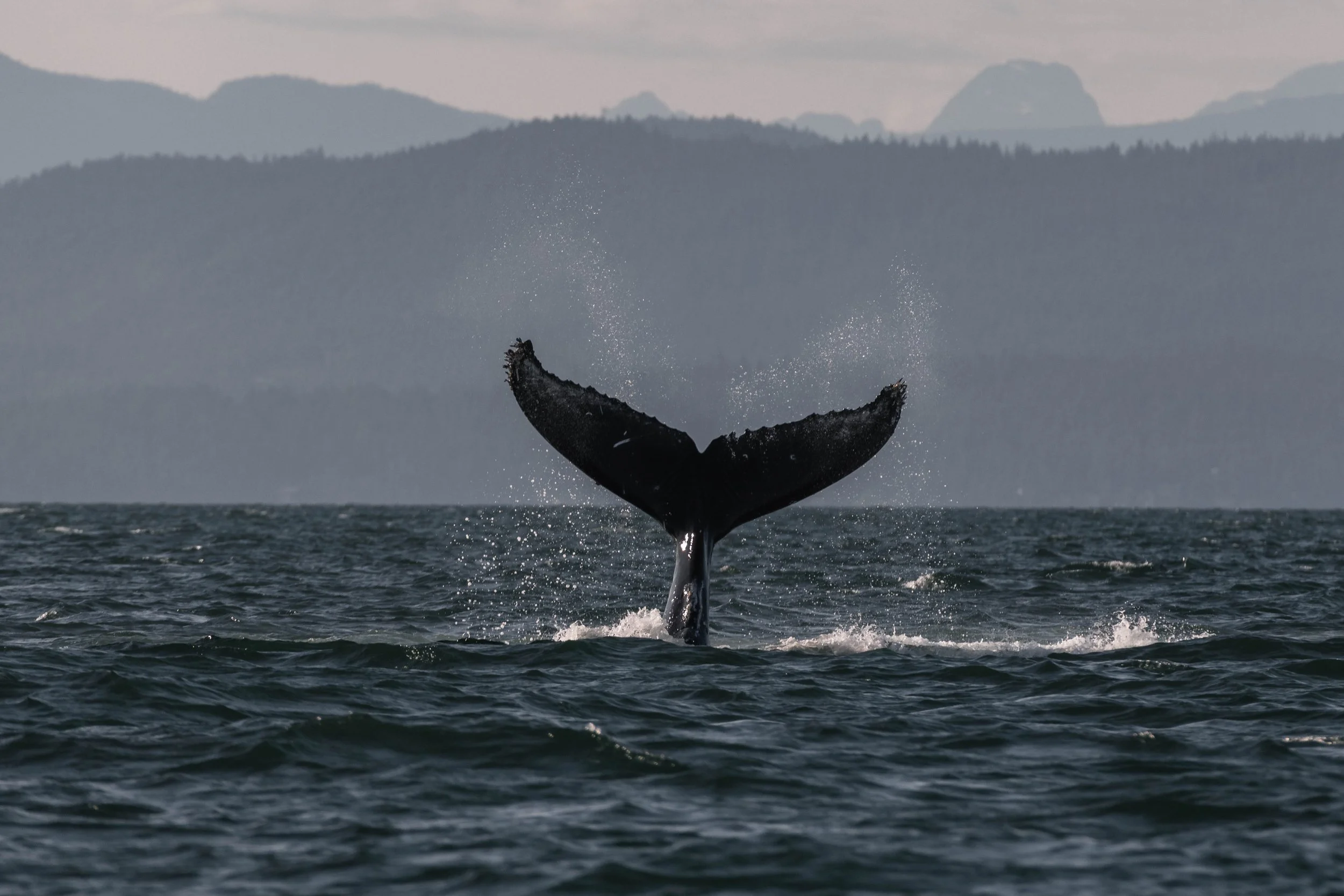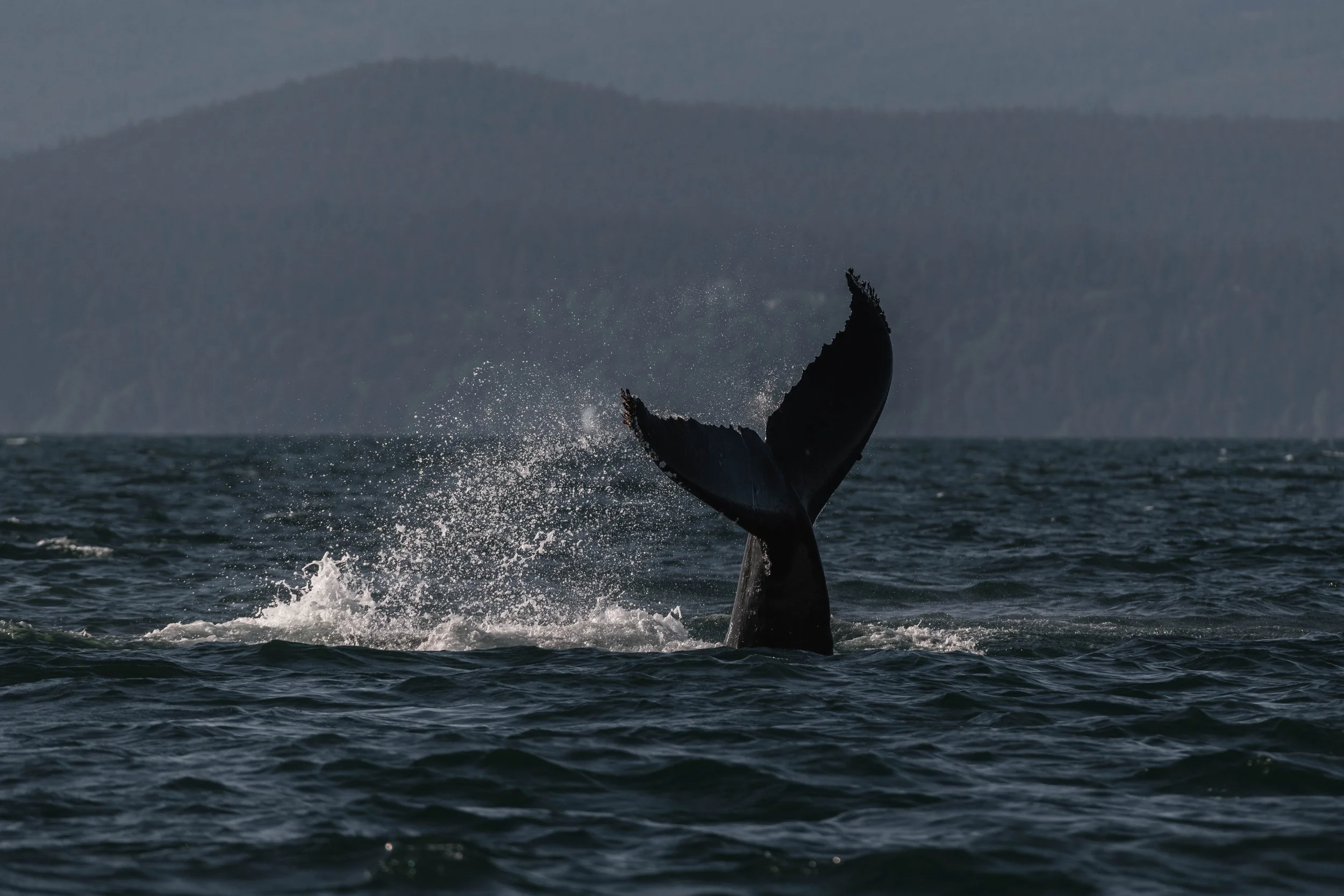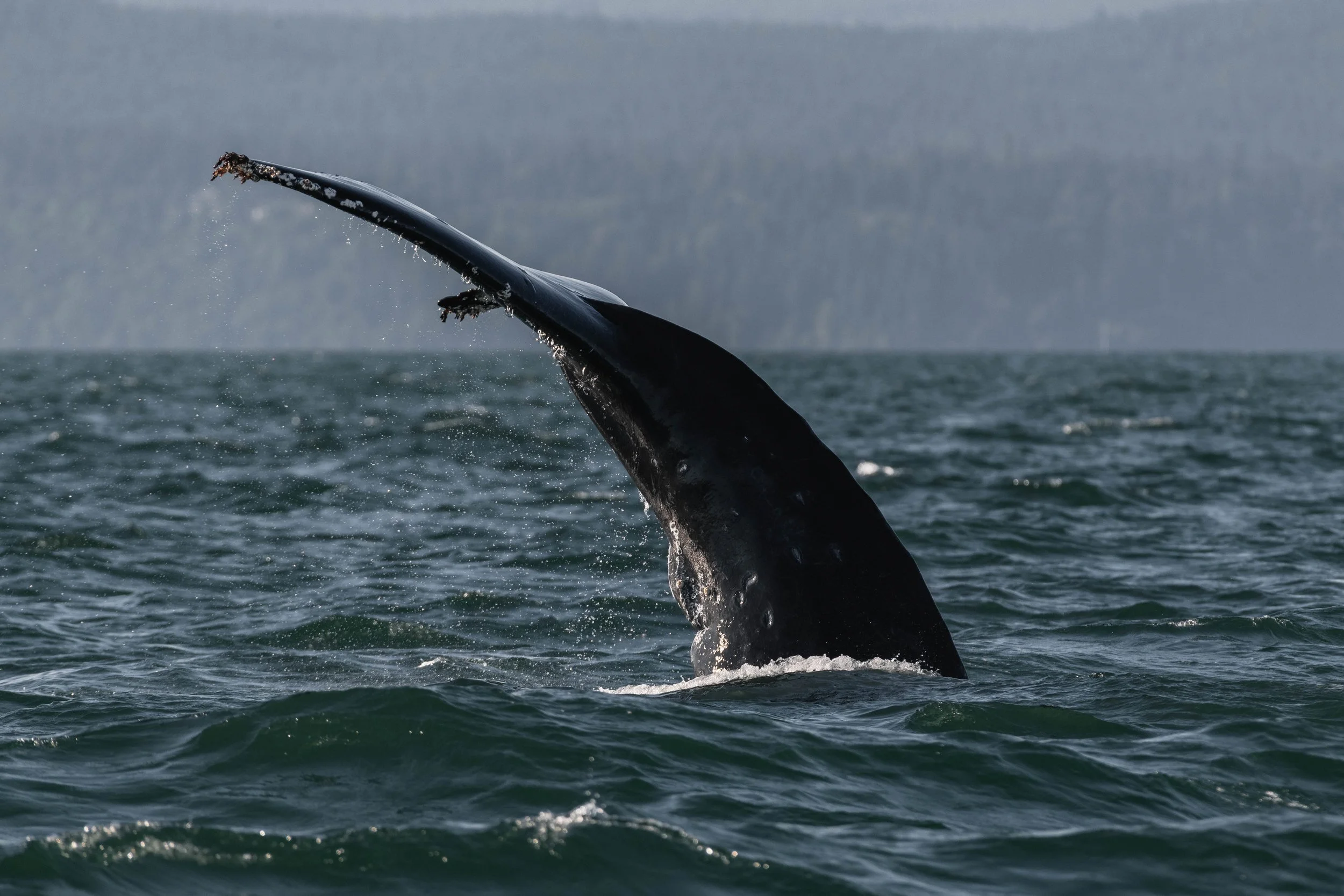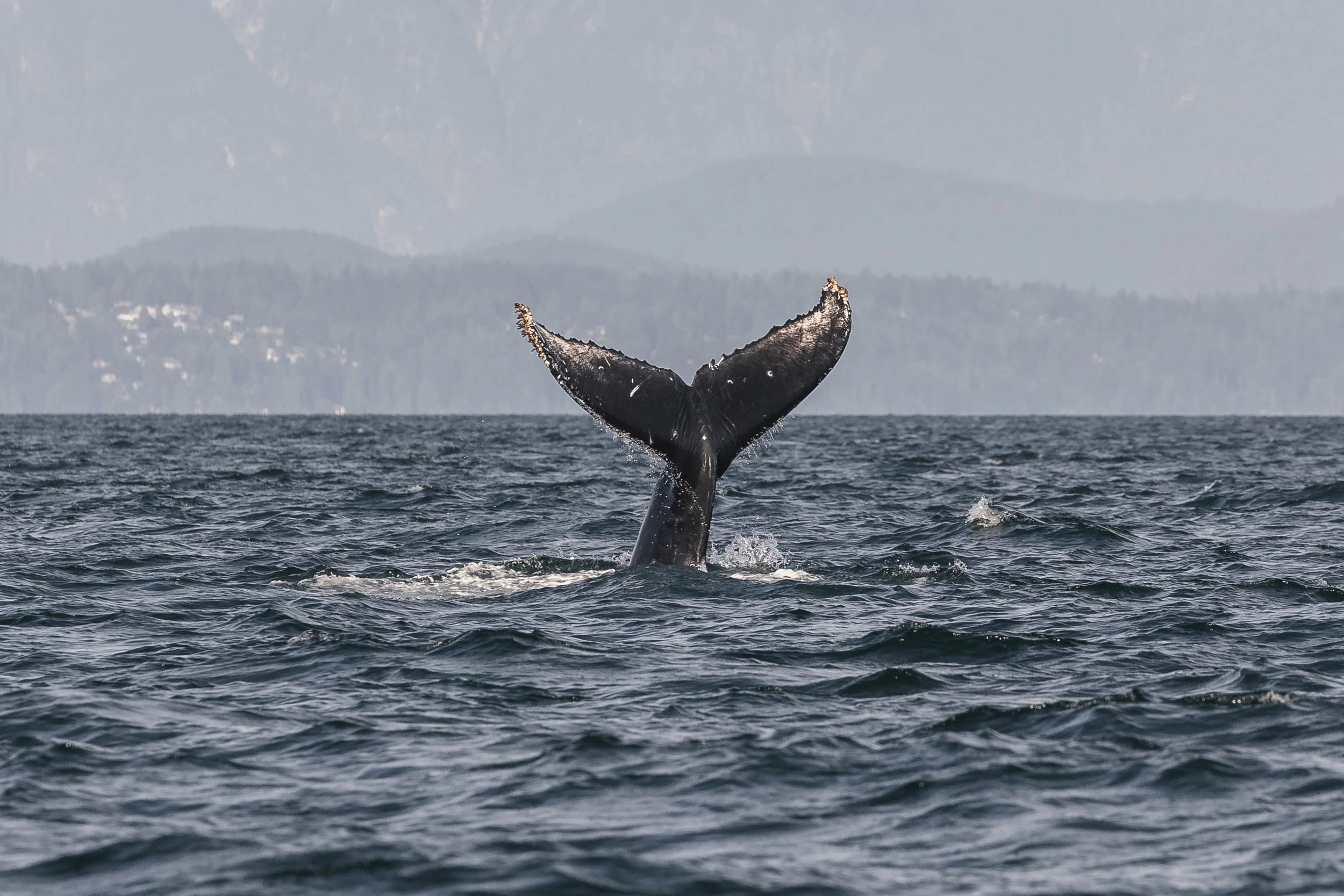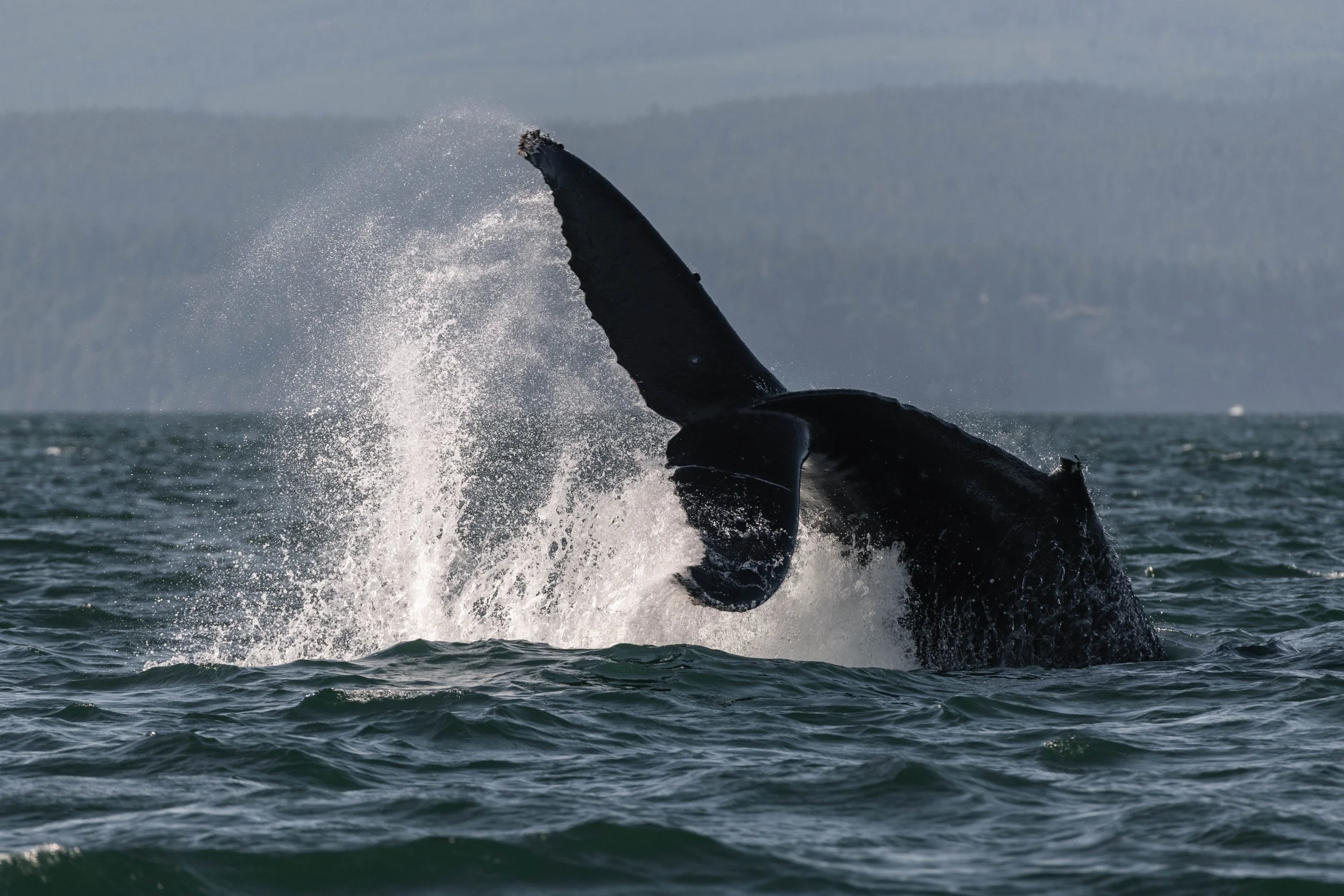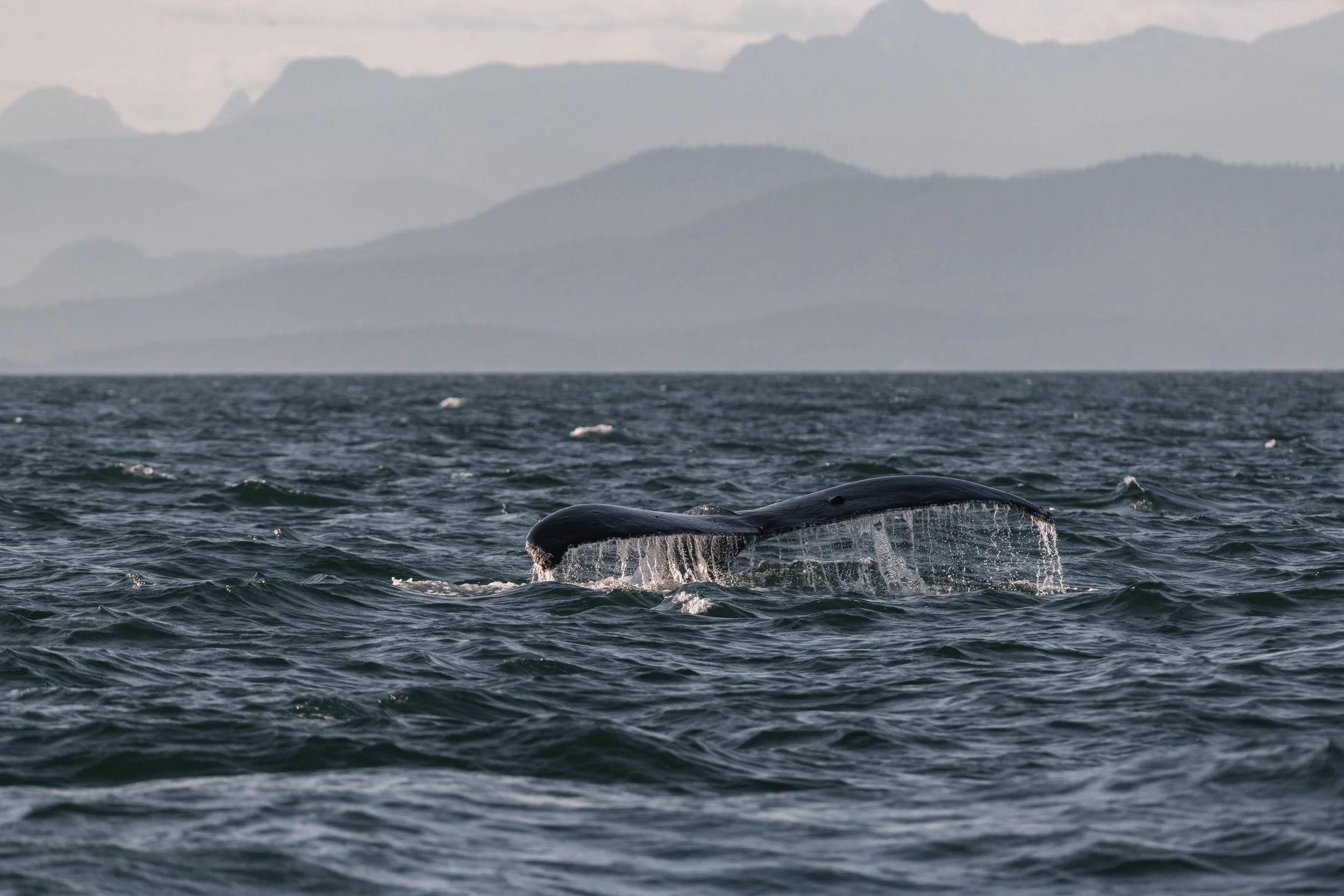July 4, 2025, 3:30 PM - It was Humpback Soup at Halibut Bank
This afternoon, both our open and semi-covered boat set off from Nanaimo Harbour, venturing into the shimmering waters of the Strait of Georgia with high hopes and clear skies. To maximize our chances of finding whales, the vessels spread out across the water, scanning the horizon for the telltale blow of a humpback—and it didn’t take long before each boat struck gold and found their own pair of whales.
The semi-covered boat enjoyed some time watching Grizzly (BCY1330) and Spock (BCY1134) whilst the open boat spent the start of their tour with Crackle (BCY1227) and Graphite (BCX2077). Watching these giants travel in tandem, diving and surfacing in near-perfect synchrony, is always a breathtaking experience.
Not so long ago, humpbacks were thought to be largely solitary creatures, rarely seen spending time together. But in just the past five years or so, our understanding of their social behaviour has shifted dramatically. Increasingly, we’re observing pairs, trios, and even small groups of humpbacks travelling and feeding together, suggesting these whales are far more social than we once believed. This change reflects the resilience of the whales themselves. During the height of commercial whaling in the 19th and 20th centuries, humpback populations were decimated by over 95%, bringing them to the brink of extinction. For decades, their numbers were so low that sightings—especially of social groups—were exceedingly rare. But since the global ban on whaling in 1986, humpbacks have staged an extraordinary comeback. From a low of fewer than 5,000 individuals worldwide, their population has rebounded to an estimated 135,000 and climbing. This incredible recovery is more than just a conservation success story—it’s opening new doors for science. As more humpbacks return to our coastlines, researchers are beginning to unlock the complex social dynamics of these majestic whales. Every encounter out here is not just awe-inspiring—it’s a glimpse into a wild world we’re only just beginning to understand.
After spending some quality time with our respective humpback pairs, we resumed our search—and it wasn’t long before something dramatic on the horizon caught our eye. A massive splash erupted in the distance, followed by another, and we knew we had to investigate. As we approached, we found the source of all that action: a Humpback Whale identified as Helen (BCX1710calf2022), who was hanging out near the ODAS buoy. This buoy marks the shallowest point of Halibut Bank, an underwater hill that rises sharply from the seafloor of the Strait of Georgia. While most of the Strait plunges to depths of over 1,000 feet, the top of Halibut Bank comes up to just about 65 feet below the surface. This unique underwater feature makes it a hotspot for marine life. Cold, nutrient-rich water gets pushed upward along the slope of the bank, fueling a bloom of phytoplankton, which supports clouds of zooplankton and, in turn, attracts schools of small fish. It’s a perfect recipe for a humpback feast, and Helen seemed to be thoroughly enjoying the buffet. Full of energy, they treated us to a spectacular breach, launching their massive body out of the water. It’s always breathtaking to witness, especially when you remember that humpbacks can weigh up to 40 tonnes. Each breach burns an enormous amount of energy, roughly the equivalent of a human running a marathon. So when they breach, it’s not just impressive, it’s extraordinary.
Following our encounter with Helen, we took a trip to the White Islets to enjoy some of the other wildlife our area has to offer. The spectacular Stellar Sea Lions and the harmonious Harbour Seals like to haul out here. There are a few ways to spot the difference between our Pinnipeds: sea lions have external ear flaps and can rotate their hind flippers under their bodies, which allows them to "walk" on land. Seals have no external ears and move on land by wriggling on their bellies, looking a bit like big, slippery sausages! One of the easiest ways to tell the difference, though, is by listening; sea lions are usually growling and roaring at each other on the crowded haul-outs, whereas the seals are much quieter and we rarely hear them make any noise.
As we began our journey back across the Strait of Georgia, spirits were already high after a fantastic afternoon with multiple humpback whales, but nature wasn’t quite done with us yet. Yet again around Halibut Bank, we spotted another spout in the distance, followed by a flash of movement. We approached carefully and were met with an absolute showstopper, an energetic humpback bursting with personality. This whale, recently added to our identification catalogue as KEX0082, hasn’t yet been given a name, but it certainly made an impression. It was full of life, tail-slapping with gusto, rolling into cartwheels, pec-slapping the surface, and launching into powerful breaches. To witness such exuberant behaviour from one of the ocean’s true giants is always something special, a reminder of just how vibrant and alive the Salish Sea is.
Our semi-covered boat headed back to Nanaimo, but our open boat crossed paths with another pair of whales on their journey home, Big Mama (BCY0324) and her 2025 calf! A legendary matriarch in these waters, Big Mama holds a special place in our hearts as the first humpback to return to our region after the whaling era and seeing her with a calf at her side, healthy, growing, and learning the ropes of life in the Strait, is both heartwarming and hopeful.
From action-packed acrobatics to the quiet grace of a mother and her baby, it was a day filled with unforgettable highlights, another perfect example of why we never tire of exploring these waters. Please enjoy the photos of the tour taken by Marine Naturalists Aly Kohlman and Hayleigh Hilbert.
Grizzly surfacing in the waves. Photo by Hayleigh Hilbert.
Crackle’s dorsal fin. Photo by Aly Kohlman.
Graphites dorsal fin. Photo by Aly Kohlman.
A close looks at the tubercles on Graphites nostrils. Photo by Aly Kohlman.
The underside of Graphites tail with crackle diving beside him. Photo by Aly Kohlman.
Helens dorsal fin. Photo by Aly Kohlman.
Helens sideways tail with Mt. Baker in the background. Photo by Aly Kohlman.
Helens dorsal fin. Photo by Hayleigh Hilbert.
A breach from Helen. Photo by Aly Kohlman.
Keta watching Helen. Photo by Hayleigh Hilbert.
A Steller Sea Lion lounging on the White Islets. Photo by Aly Kohlman.
A very cozy looking haul out of Steller Sea Lions. Photo by Aly Kohlman.
This large male Steller Sea Lion on White Islets. Photo by Aly Kohlman.
A sea lion leaping from the rocks into the water. Photo by Hayleigh Hilbert.
Harbour Seals on the White Islets. Photo by Aly Kohlman.
KEX0082 tail lobing. Photo by Aly Kohlman.
KEX0082 flicking their tail in the air. Photo by Aly Kohlman.
KEX0082 throwing their tail in the air. Photo by Aly Kohlman.
Another tail lob from KEX0082. Photo by Aly Kohlman.
We can see that KEX0082 has been entangled since we last saw them. Photo by Aly Kohlman.
A very active KEX0082. Photo by Aly Kohlman.
A upside down tail fluke from KEX0082. Photo by Aly Kohlman.
A great look at KEX0082 fliking their tail. Photo by Aly Kohlman.
KEX0082 with their tail in the air. Photo by Aly Kohlman.
KEX0082 flicking their tail at the surface. Photo by Hayleigh Hilbert.
You can see some of the new scarring in this photo. Photo by Hayleigh Hilbert.
A great look at the tail lobbing KEX0082. Photo by Hayleigh Hilbert.
KEX0082’s pectoral fin in the air. Photo by Hayleigh Hilbert.
KEX0082 breaching. Photo by Hayleigh Hilbert.
Cartwheel from KEX0082. Photo by Aly Kohlman.
Big Mama’s calf. Photo by Aly Kohlman.
Big Mama going for a dive. Photo by Aly Kohlman.
The underside of Big Mama’s tail. Photo by Aly Kohlman.












